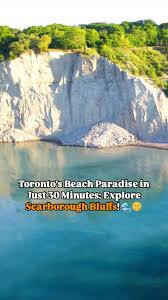
Introduction to Scarborough Bluffs
Scarborough Bluffs, located along the eastern shoreline of Lake Ontario in Toronto, are a series of majestic cliffs that rise up to 65 meters (213 feet) above the lake. This stunning natural landmark not only offers breathtaking views but also serves as a crucial eco-tourism site, attracting thousands of visitors each year. With its unique geological compositions and the surrounding conservation areas, the Scarborough Bluffs are a vital part of Toronto’s environmental and recreational landscape.
Geological and Ecological Significance
The Scarborough Bluffs were formed approximately 12,000 years ago during the last Ice Age. Comprised primarily of soft sedimentary rock, the bluffs are constantly shaped and eroded by wind and waves, creating a dynamic landscape. As a result, the area around the bluffs is home to a diverse range of flora and fauna, making it an essential habitat for various species.
Notably, the Scarborough Bluffs are recognized as a significant stopover point for migratory birds. Birdwatching enthusiasts often visit during the migration seasons to observe species such as ducks, hawks, and songbirds. The area also features several hiking trails, which allow visitors to explore its rich biodiversity and seasonal changes in plant life.
Community and Recreational Impact
The local community appreciates the Scarborough Bluffs for their recreational offerings, including picnic areas, cycling paths, and access to beaches at the base of the cliffs. In particular, Bluffer’s Park is a popular destination for families and outdoor enthusiasts alike. Efforts by the city to maintain and enhance these spaces have increased overall accessibility and engagement with nature.
Recent reports suggest that the number of visitors has surged, especially in the wake of the COVID-19 pandemic, as people sought safe outdoor spaces. Parks Canada has noted a significant uptick in foot traffic, leading to ongoing discussions about the importance of sustainability and conservation in the area.
Conclusion
As the Scarborough Bluffs continue to attract visitors with their stunning vistas and rich biodiversity, their significance only grows. Authorities are reminded of the need for resource management and environmental protection to ensure that this natural treasure remains intact for future generations. The bluffs not only enhance the beauty of Toronto but also contribute to the city’s ecological well-being and community health. As awareness and appreciation of such natural landmarks grow, readers are encouraged to explore and participate in their preservation.

